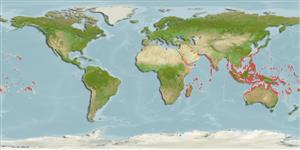Common names from other countries
Classification / Names / Names
Common names | Synonyms | Catalog of Fishes (gen., sp.) | ITIS | CoL | WoRMS
Environment: milieu / climate zone / depth range / distribution range
Ecology
Reef-associated; depth range 0 - 20 m (Ref. 8294). Tropical; 31°N - 32°S, 32°E - 138°W (Ref. 846)
Indo-Pacific. Tropical to subtropical.
Length at first maturity / Size / Weight / Age
Maturity: Lm ? range ? - ? cm
Colonies are composed of thin unifacial laminae sometimes forming tiers or whorls. Corallites are arranged in rows between coenosteum ridges, which are conspicuous and usually perpendicular to colony margins. Cream, pink or brown with pale margins (Ref. 846).
Maximum depth from Ref. 98471.
Life cycle and mating behavior
Maturity | Reproduction | Spawning | Eggs | Fecundity | Larvae
Hermaphroditic (Ref. 113712). Mature gametes are shed into the coelenteron and spawned through the mouth. Life cycle: The zygote develops into a planktonic planula larva. Metamorphosis begins with early morphogenesis of tentacles, septa and pharynx before larval settlement on the aboral end (Ref. 833).
Nemenzo, F. Sr. 1986. (Ref. 910)
IUCN Red List Status (Ref. 130435: Version 2024-1)
CITES status (Ref. 108899)
Not Evaluated
Human uses
| FishSource |
Tools
Internet sources
Estimates based on models
Preferred temperature
(Ref.
115969): 25.1 - 29.3, mean 28.4 (based on 3576 cells).
Price category
Unknown.
